Contents
- On This Page:
- Sagalassos
- Roman Baths & Lower Agora
- Lower Agora & Colonnaded Street
- Upper Agora
- Antonine Nymphaeum
- Heroon
- Roman Theater
- Eğirdir: The Base for visiting Sagalassos
- Things to Do around Lake Eğirdir
- Touring the Lavender & Rose Fields
- Hiking in Yazılı Canyon Nature Park
- Visiting Antiocheia-in-Pisidia
- Trekking the St. Paul Trail
Turkey’s lake district is one of the country’s lesser visited regions, popular with hikers and outdoor enthusiasts but receiving only a smidgen of the coast’s crowds.
Hiding in the mountains here, you’ll find its major tourist attraction: the UNESCO World Heritage site of Sagalassos.
This dramatically situated Greco-Roman ruin is surrounded by craggy peaks. The painstaking restoration of its famous Antonine Nymphaeum makes it one of the best places to visit in Turkey for being able to picture the grandeur of Ancient Rome.
The surrounding countryside of lakes, forests, and farming fields is packed full of things to do for active travelers, with the small lakeside town of Eğirdir used as a base from where hiking and mountain biking adventures can be easily planned.
For travelers who prefer a slower pace there are boating tours and road trips around the region’s abundant rose and lavender fields, abloom with color during the summer months.
This area is a great add-on to a self-drive sightseeing tour heading inland from Antalya or Pamukkale to Konya or Cappadocia. Buses on these routes all stop in Isparta, from where it’s only a short jaunt to Eğirdir by minibus.
On This Page:
- Sagalassos
- Roman Baths & Lower Agora
- Lower Agora & Colonnaded Street
- Upper Agora
- Antonine Nymphaeum
- Heroon
- Roman Theater
- Eğirdir: The Base for visiting Sagalassos
- Things to Do around Lake Eğirdir
- Touring the Lavender & Rose Fields
- Hiking in Yazılı Canyon Nature Park
- Visiting Antiocheia-in-Pisidia
- Trekking the St. Paul Trail
Sagalassos
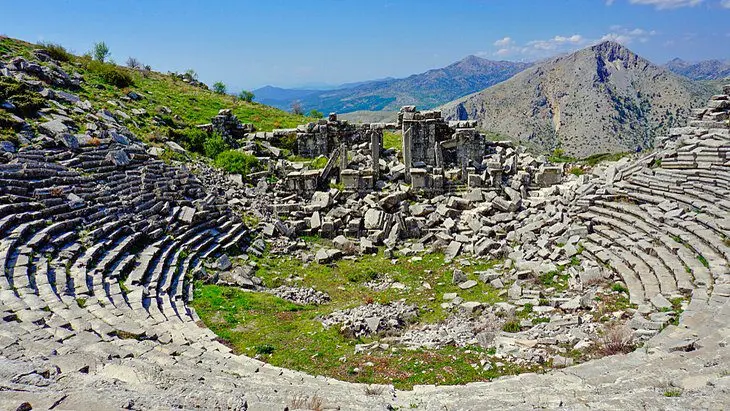
The ruins of Sagalassos, once Ancient Pisidia’s major city, sit scattered across the mountain slopes of Ak Dağ (White Mountain).
Lying between 1,400 and 1,600 meters above sea level, the city’s lofty position saved it from major looting in later centuries and there are extensive remains to be seen.
Sagalassos has habitation roots stretching back at least to the Iron Age, but its heyday began when it was captured by Alexander the Great.
Later, it was a favorite city of the Roman Emperor Hadrian, and most of the structures here date from its period under Roman control.
Wear good walking shoes if you want to fully explore the steep site, and bring along plenty of water, as the only chance to buy food and drink is at the café next door to the ticket office, which sits at the lowest reaches of the site.
Roman Baths & Lower Agora
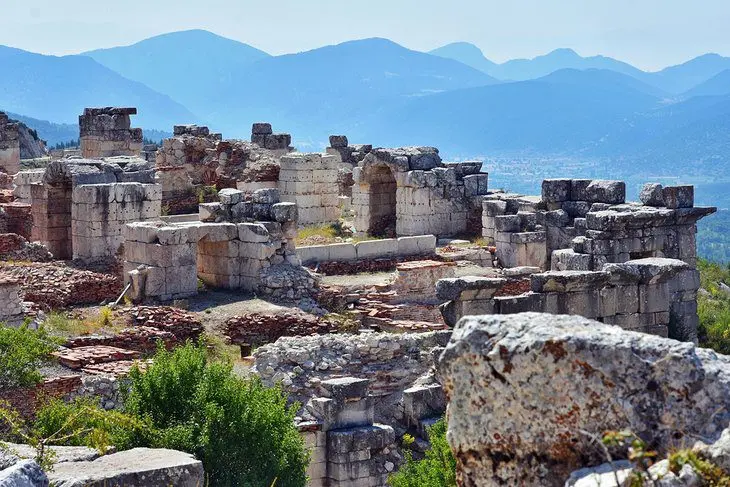
On the lower slopes of the city, the first major set of ruins you come to are the Roman Baths.
The Roman Baths complex at Sagalassos is where archaeologists excavated a colossal (one-meter-high) head of the Roman Emperor Hadrian that is renowned for its artistic beauty. If you want to see the head, and many of the other finds from archaeological work here, head to Burdur Museum before or after your visit.
The Sagalassos baths are a mammoth example of Roman-era bathhouse architecture, it’s also the oldest Roman baths complex found in what was Rome’s Asia Minor region.
This highlights how favored this city was within Rome’s expansive lands, as the city’s population is estimated at only around 5,000, yet it was graced with an enormity of civic buildings.
Lower Agora & Colonnaded Street
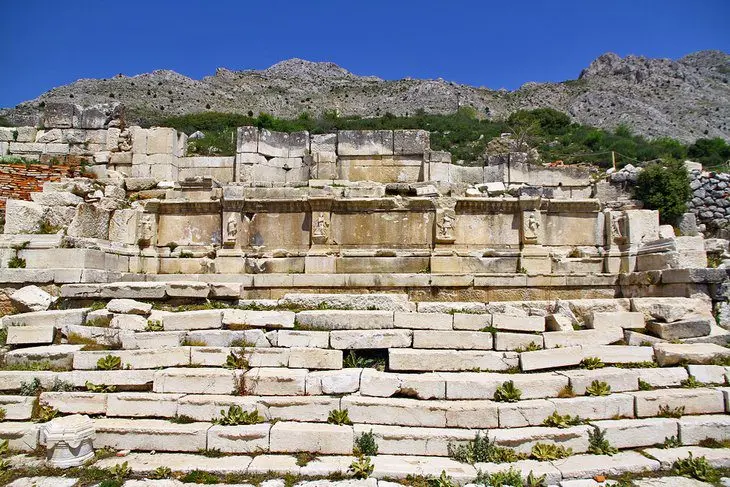
From the Roman Baths, head onto the Colonnaded Street, which would have been the city’s main road.
Follow the Colonnaded Street south first to arrive at a Shrine platform dedicated to the Roman emperors Hadrian and Antoninus Pius. Then retrace your steps, and pass under the Tiberian Gate to view the Lower Agora civic buildings clustered at the street’s northern end.
The Lower Agora is home to two well-restored nymphaeum (public fountains) buildings and a ruined odeon (small theater).
The Hadrianic Nymphaeum is the Lower Agora’s most impressive structure, with plenty of its statuary and decoration still intact.
Heading up the steep slope from the odeon to the Upper Agora, you pass the Macellum (Roman food market) along the way.
Upper Agora

The Upper Agora area has been the main focus of archaeological restoration work at Sagalassos, and it is here that you really can take in the grandeur of this site.
The expansive marble courtyard with re-raised colonnades and statuary is a prime location for dramatic site photos, backed by jagged peaks and with views down across the lower reaches of the site.
This is where the political life of the city was played out, and to the side, you’ll find the bouleuterion (a Roman council hall) and the remnants of a Doric temple, as well as the ruins of a later Byzantine church.
Antonine Nymphaeum
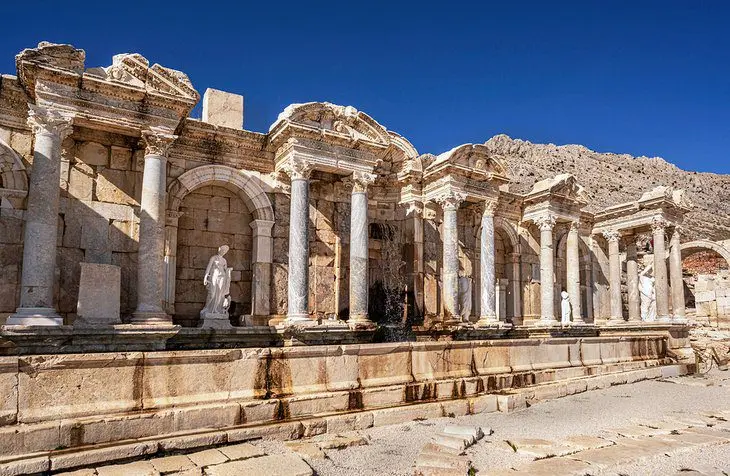
This is the Upper Agora’s major monument and the most impressive structure in Sagalassos.
While traveling around the Roman-era sites of Turkey, you’ll come across many nymphaeums (public fountains) but none like the Antonine Nymphaeum.
Unlike all the other nymphaeums, which lie in partial ruins, the Antonine Nymphaeum has been fully reconstructed and has been made fully functional. Fountains of water plunge into its basins, which sit between marble columns and finely detailed statuary (some original and others recreations).
The nymphaeum’s restoration, finished in 2010, was one of the most spectacular, and ambitious, restoration projects on a Roman-era site in Turkey, and the structure rates up there with the library in Ephesus as Turkey’s most important Roman period buildings.
Heroon
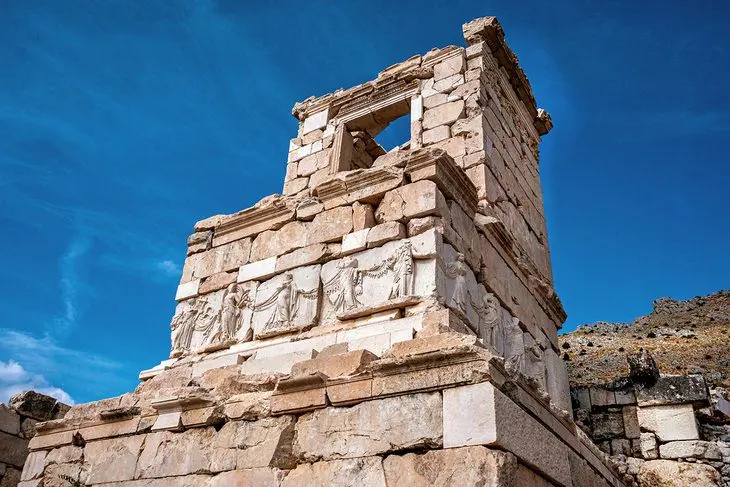
Just up the slope from the Upper Agora area is the Heroon, rising for 14 meters high from its plinth.
A heroon is a Greco-Roman period shrine dedicated to a heroic character, and this one dates from the 1st century, though the person it was dedicated to remains unknown.
An incredibly well-preserved frieze of dancing nymphs wraps around the base of the monument.
From here, you can either walk west around the mountain slope to the scant remains of Sagalassos’ Stadium on the city’s edge, or east to the Neon Library.
The Neon Library dates from AD 120 and is home to a fine mosaic floor. It’s sometimes kept locked, so to be sure you can gain entry; ask the ticket office for the key when you buy your site ticket.
Roman Theater

Just to the east of the Neon Library, sitting at one of the highest points in the site, is the Roman Theater, noted for being one of the finest surviving theaters in Turkey.
It once sat 9,000 spectators, though today, the stage area and some of the seating sections lie in ruins due to the earthquakes that wracked Sagalassos in the 6th and 7th centuries and contributed to the city being abandoned completely.
If you puff your way up to the highest tier of seating, you’ll be rewarded with panoramas both back across the city and out across the mountains.
Eğirdir: The Base for visiting Sagalassos
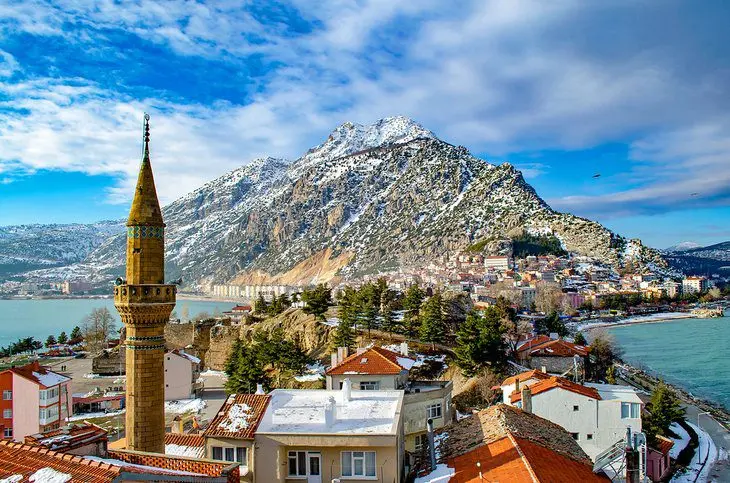
Sagalassos can be visited as a day trip from Antalya (119 kilometers to the south), but the surrounding district (called Turkey’s Lake District) is a closer rural alternative and is a favorite with hikers, cyclists, and nature lovers.
The main base in the Lake District is the small town of Eğirdir, backed by mountains and sitting on the bank of Lake Eğirdir.
While the main part of Eğirdir spreads out along the lakeshore, a causeway from town leads out onto the lake to the island of Yeşilada, which is a quiet suburb of the main town.
The accommodation options, both in the main town and on Yeşilada, are small, locally run, and homely, so they suit independent travelers.
Things to Do around Lake Eğirdir

Mountain bike rental is hugely popular in Eğirdir, and many people come here to cycle the forest routes around the lake.
In summer (from mid-June to mid-September) full-day boat trips on Lake Eğirdir are the most popular local activity. The trips encompass various stops at isolated bays for swimming and lunch, as well as providing panoramic vistas of the craggy peaks bordering the lake.
There are also various beaches rimming the main towns along Lake Eğirdir’s shore, including on the outskirts of Eğirdir itself, though they’re a more drab option than the Mediterranean shore, which is only 100 kilometers south.
Touring the Lavender & Rose Fields
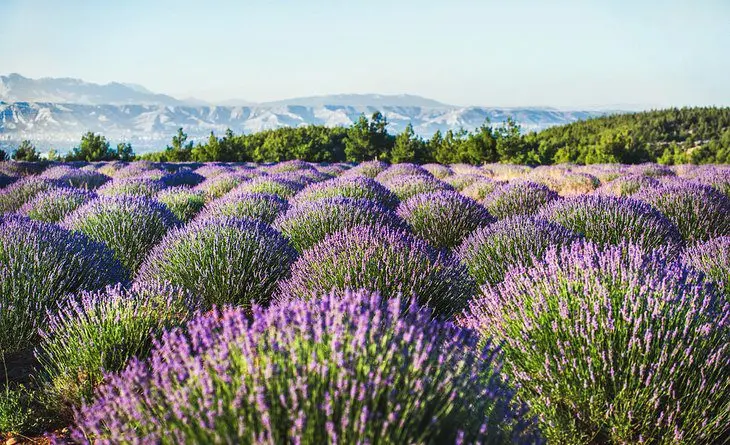
This area is one of Turkey’s agricultural heartlands, and from spring to fall there’s always plenty of harvesting action. For travelers though, it’s most well-known for its rose and lavender harvests.
The city of Isparta (36 kilometers southwest of Eğirdir) is the center of Turkey’s rose industry, and the surrounding countryside produces approximately 60 percent of the world’s rose oil, all made from Damask roses, which were brought into Turkey in the late 19th century.
From May to June, rose harvest tours are arranged that involve trips to the major rose fields either in “Rose Valley,” near the village of Güneykent, or in the fields around the village of Yeşilyurt. Tours involve helping to harvest the roses and visits to the factories where the roses are processed to make the oil.
If you’re in the area later in the year, the lavender fields around the village of Kuyucak, near Lake Burdur, are in full bloom from July to August. The village promotes itself as Turkey’s “Lavender Village,” and locals make and sell plenty of lavender products at stalls here. Tours to help harvest the lavender can be arranged in July.
Hiking in Yazılı Canyon Nature Park
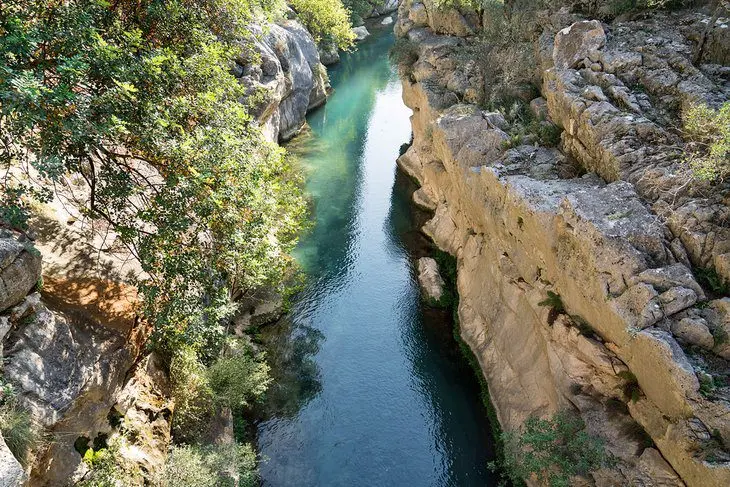
Yazılı Canyon, 56 kilometers south of Eğirdir, is a lush gorge with pine-tree-rimmed walking paths above an ice-blue river, all backed by mountain peaks in the distance. The normal day-tripper path rims the canyon wall the entire way for an easy three-kilometer walk that ends by a series of natural pools.
If you want to swim, wear your swimsuit underneath, though be aware that even in the height of summer, the water here is very cold.
The multiday St. Paul Trail thru-hike runs through Yazılı Canyon, so there are more ambitious hiking paths for visitors with more time. Most people, though, are here for the short amble and just enjoy the scenery and tranquil ambience of the area.
Visiting Antiocheia-in-Pisidia
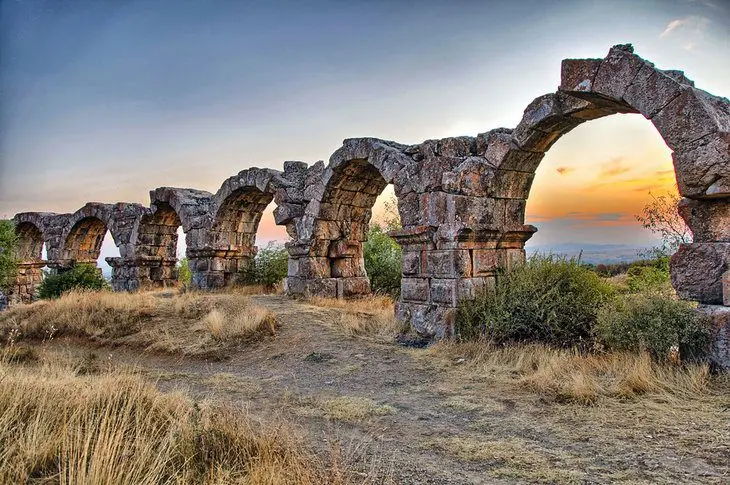
On the outskirts of the town of Yalvaç (73 kilometers northeast from Eğirdir) are the remnants of Antiocheia-in-Pisidia, which was once Ancient Pisidia’s important border town.
As with many ancient town ruins in Turkey, history of this site stretches much further back than the Classical Era (Antiocheia-in-Pisidia has been settled since the 3rd Century BC at least), but what you see today are the newer Greco-Roman and Byzantine monuments.
For those of the Christian faith, Antiocheia-in-Pisidia is important, as it was visited by both St. Paul and St. Barnabas, though their first visit was unsuccessful, and the early Christian missionaries where expelled from the city.
The area of ruins here is extensive, despite the fact that much of the city remains to be excavated.
The Augusteum Temple is one of the most impressive monuments, dedicated to the Emperor Augustus, while from the remnants of the Nymphaeum, you can climb up the hill following the ruins of the city’s aqueduct up to a fully preserved arched aqueduct section.
Another monument not to miss while rambling around the site is the Great Basilica, dating from the 4th century and thought to be one of the earliest basilica-style churches built in Turkey.
Trekking the St. Paul Trail
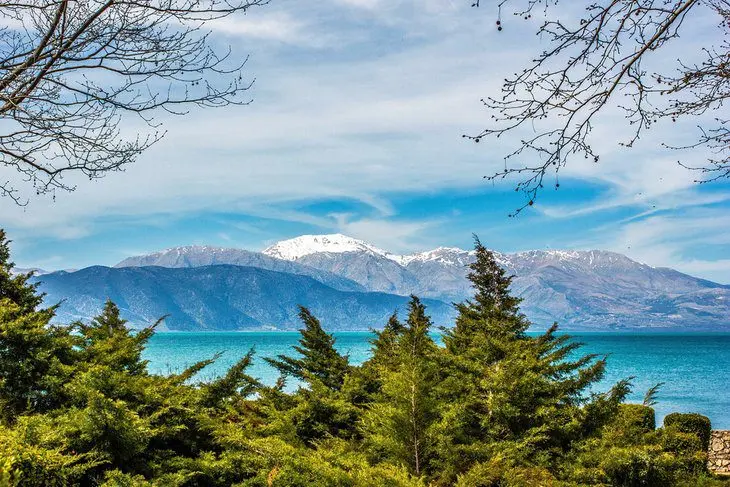
The St. Paul Trail is one of Turkey’s most famous long-distance hikes stretching for 500 kilometers between Perge, near Antalya, and Yalvaç.
It roughly traces St. Paul’s missionary journey through what was Roman Asia Minor, and uses old Roman roads and shepherding tracks as it heads from the coastal plains up into the mountains.
Eğirdir is the best known base for the trail, with many thru-hikers heading in either direction spending a few days resting up in town before continuing onwards, while others use Eğirdir as their starting or finishing point when hiking a shorter section of the trail.
The full trail is a hardy endeavor that suits experienced hikers and takes around 27 days to complete.









